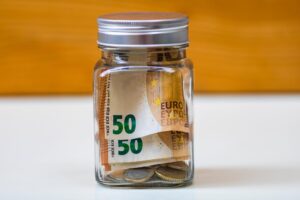
The November collapse of bitcoin from levels above $120 thousand to the zone of about $80 thousand was a cold shower for retail investors – primarily young investors, for whom crypto has long become not an exotic, but the main “investment” instrument. But the current correction has not destroyed the interest, but only exposed what professionals have been saying for a long time: in the eyes of some young people, the crypto market looks more and more like high-risk betting rather than classic investments.
A fresh survey by YouGov and Young Men Research Project, published by MarketWatch, shows a generational gap in financial behavior. Among U.S. men ages 18-29:
28% own crypto assets (cryptocurrency and/or cryptocurrency ETFs),
while only 21% are saving for retirement through 401(k) and other classic retirement plans.
Bitcoin remains the “anchor” of the portfolio, followed by Ether and Solana; the share of meme-coin investments is noticeably smaller, but these are the ones that reinforce the impression of a “casino approach” to money management. What’s also important is who exactly we see in these statistics. The research shows:
the higher the income and education level, the more likely a young person is to have both a crypto and a classic retirement account;
among freelancers and those in non-standard forms of employment, crypto is often the only “long term” asset – they simply don’t have access to retirement plans.
So this is not just a story about “irresponsible players” – in many ways it is a reaction to the new conditions of the labor market, where stability and a social package have become a luxury.
For some young people, crypto fulfills several roles at once:
Financial elevator. Against the backdrop of low housing affordability, expensive education and de facto stagnant wages, the temptation to “jump the ladder” through a successful entry into BTC or altcoin is very high. Stories of early holders with X10-X50 fuel expectations.
Part of the online culture. Crypto is embedded in the ecosystem of YouTube, Reddit, X, Discord. There’s also betting, trading, sports betting. For many, it’s a unified medium of pastime and risk. Researchers directly record the intersection of the audiences of cryptoinvestors and online gambling fans.
Distrust of the “old” system. Pensions and traditional funds are associated with bureaucracy, slow returns and lack of control. Crypto, on the contrary, seems to be an instrument of “personal freedom” – even if the real control is limited to knowing a couple of apps and passwords.
All of this makes the crypto market susceptible to waves of FOMO and panic. The November dip after historic highs showed how painful such swings can be for those who went in “on the shoulder of hope” rather than as part of a well-thought-out strategy.
1. The risk of a “lost decade” for personal finances.
If a significant portion of a generation is betting almost exclusively on crypto rather than a diversified portfolio and retirement savings, every major market drawdown sets their financial goals back years. It’s not just about balance sheet decline – it’s about psychological “burnout” from investing itself.
2. Increased market volatility.
The greater the share of participants with a short horizon, high risk tolerance and “game” orientation, the more the market resembles a derivative casino. This amplifies the amplitude of movements and increases the likelihood of sharp drops when macro backdrop or regulatory news deteriorates.
3. Field for regulators.
Crypto’s growing share of youth savings is almost guaranteed to increase regulatory attention, from the US to the EU to emerging markets. Already, restrictions on the marketing of high-risk products, requirements for exchanges to protect unqualified investors, and tighter KYC/AML controls are being discussed.
For countries like Ukraine, where the share of cryptoactive youth is also high, these trends mean an inevitable dialog: how to develop an innovative market without turning it into a mass trap for personal finance.
Outlook: three scenarios beyond November
If we look at the end of the year and 2026 through the lens of retail investors, we can roughly distinguish three scenarios:
“Nervous Stabilization” (baseline).
Bitcoin and large altcoins trade in a wide corridor, some retailers record losses and go into stablecoins or cache, but a core of young holders remain in the market. Crypto is gradually being integrated into more conservative products (ETP, funds), and the growth of interest compensates for the partial outflow of the disappointed.
New wave of euphoria.
Against the backdrop of falling rates, inflows of institutional capital or “Bitcoin in retirement plans” style news, we see a rally again. Young people see the November drawdown as “one more chance to get in” and the market structure becomes even more fragile due to increased shoulder demand.
Regulatory shock.
A major scandal, the collapse of another exchange or a tough package of restrictions in one of the jurisdictions may provoke not only a price spill, but also a mass exit of a part of retail. Against this background, interest in classic instruments (ETFs on indices, bonds, pension plans) temporarily increases.
Which scenario will be realized depends largely on macroeconomics, central bank policy and the depth of future regulatory reforms.
The November collapse showed the main fork for a young investor: to stay in the logic of rates or to switch to the logic of strategy. The answer to this question will determine not only the future bitcoin exchange rate, but also the financial health of an entire generation.

The Dnipro-based Sol Union group of companies has begun construction of the Neo Food System factory in the Kyiv region. The project capacity of the enterprise will allow it to produce 60,000 ready-made meals per day. The factory will produce ready-to-eat chilled, pasteurized, sterilized, and deep-frozen meals. The group’s investment in this project amounts to UAH 220 million.
This was announced by Dmytro Kysilevsky, Deputy Chairman of the Verkhovna Rada Committee on Economic Development. He noted that Sol Union took advantage of several programs of the “Made in Ukraine” policy for the development of Ukrainian manufacturers to implement its current investment projects. In particular, the group took advantage of a state grant of UAH 8 million for processing, purchasing autoclaves manufactured by the Rozfood plant in Kyiv. In addition, the group attracted loans from the “5-7-9” program. It plans to further expand its loan portfolio.
The launch of the plant will create 260 new jobs in the Kyiv region. The production area is 4,000 square meters.
To implement the Neo Food System factory project, the group purchased a ready-made industrial premises that already has the necessary connected electricity, water supply, treatment facilities, and drainage. The installation of the enterprise’s equipment will begin in April 2026. The launch of production is scheduled for June, and the project is expected to reach its design capacity in September 2026. The first exports to EU countries are planned for 2027.
The Sol Union group of companies includes two food production and packaging factories, a vegetable storage facility with a capacity of 5,000 tons, and warehouses with a total area of 17,000 square meters. Until now, all of the group’s enterprises were located in Dnipro.
The “Made in Ukraine” development policy for Ukrainian manufacturers combines state programs aimed at developing production, attracting investment, and stimulating exports.
FACTORY, FOOD, Kysilevsky, PRODUCTION, semi-finished product

BGV Group Management signed a memorandum on further cooperation with two companies in the construction sector during a meeting of the Joint Ukrainian-Saudi Business Council, the BGV press service told Interfax-Ukraine .
The meeting of the Joint Ukrainian-Saudi Business Council brought together representatives of government institutions, relevant organizations, and leading companies from Ukraine and the Kingdom of Saudi Arabia. The Ukrainian side in Riyadh was represented by private companies from key economic sectors, which together employ more than 150,000 people and account for about 4% of the country’s GDP. The total potential of the projects presented in the capital of the Kingdom exceeds $1 billion.
The memorandum signed by BGV Group Management provides for negotiations, exploration of joint opportunities, and planning of specific steps to implement potential projects.
In addition, the BGV team participated in the UNIDO conference, where it discussed future areas of cooperation with partners from Saudi Arabia. The company also joined the promotional event “Investment Dialogue: Mobilizing Gulf Capital For Sustainable Industrial Growth In Ukraine,” where it presented its own investment initiatives, particularly in the field of mineral extraction.
As a result of the Council’s work, the parties agreed to create industry working groups, prepare a roadmap for cooperation, and plan the next meeting in an expanded format.
BGV Group Management is an investment group founded by Gennady Butkevich in 2015. The company has five business areas, within which it develops projects in mining, energy and infrastructure, retail, development, and education and sports. Since 2022, the BGV team has begun to focus on development, given the priority of restoring and constructing new residential, commercial, and other infrastructure facilities in Ukraine.
Since 2022, BGV has begun to focus on development, given the priority of restoring and constructing new residential, commercial, and other infrastructure facilities in Ukraine. In June 2024, a new company, BGV Development, which is engaged in development projects, joined the group. The construction ecosystem includes a manufacturer of aerated concrete under the Poriston brand (formerly Aerok), with three projects completed and five in progress, including the Equides Villas cottage community and two residential projects in partnership with SAGA Development.

In January-November of this year, Ukrainian mining companies reduced exports of iron ore raw materials (IORM) in physical terms by 4.9% compared to the same period last year, from 30 million 250,394 thousand tons to 28 million 774,717 thousand tons.
According to statistics released by the State Customs Service (SCS) on Friday, foreign currency proceeds from iron ore exports decreased by 14% during this period, from $2 billion 530.162 million to $2 billion 176.431 million.
Exports of raw materials were mainly to China (44.94% of shipments in monetary terms), Slovakia (17.24%), and Poland (16.26%).
In addition, in January-November 2025, Ukraine imported mineral resources worth $92,000 in the amount of 128 tons from the Netherlands (47.83%), Italy (38.04%), and Norway (14.13%), while in the same period last year it imported 2,031 tons worth $409 thousand.
As reported, in 2024, Ukraine increased its exports of raw materials by 89.8% compared to 2023, to 33 million 699.722 thousand tons, and foreign exchange earnings grew by 58.7%, to $2 billion 803.223 million UAH.
In 2024, Ukraine imported mineral resources worth $414,000 in a total volume of 2,042 tons, while in 2023, 250 tons of these raw materials were imported worth $135,000. In 2023, exports of raw materials decreased by 26% in real terms compared to 2022, to 17 million 753,165 thousand tons. Foreign exchange earnings amounted to $1 billion 766,906 million (a decrease of 39.3%). A total of 250 tons of raw materials were imported for $135,000.

“Ukrnafta continues its digital transformation. Today, artificial intelligence is becoming one of the key tools that helps the company to work more accurately with subsoil, make more informed technological decisions and increase production efficiency.
Ukrnafta’s Research and Design Institute has created five neural network-based tools that are already changing the approach to geology and field development planning.
1. Automatic processing of large amounts of geological and industrial data.
Specialists perform data mining, recognize text and document structure in images, and automatically translate documents into Ukrainian. By July 2026, it is planned to complete the full processing of 1.8 million scanned paper carriers and create a full-fledged digital archive of geological and industrial documentation.
2. Recognizing and classifying geophysical measurement curves in images.
Neural networks significantly accelerate and improve the quality of the digitization process of scanned well logs. As a result, specialists receive the critical data they need to analyze and determine the location of productive formations and their characteristics faster. Additionally, a module has been created to automatically link a set of geophysical survey curves by depth using neural networks.
3. Automatic interpretation of lithological and petrophysical characteristics
A powerful tool for analyzing geophysical surveys that reproduces the logic of an experienced interpreter, automatically generating a preliminary forecast of important characteristics over the entire depth of the section. This allows you to clarify reservoir boundaries, find potentially productive intervals, and make field development strategies faster and more accurate.
4. Data preparation for digital 3D field models
The full cycle of preparing input data for digital field models has been automated. In fact, we are forming the basis for digital fields – digital twins that help manage the field in real time.
5. A recommendation system for selecting candidate wells for stimulation activities.
Neural networks are used to analyze the accumulated experience of technological operations and forecast possible flow rates for each well after stimulation. This approach allows us to quickly identify for further analysis exactly those facilities where workovers can provide the greatest increase in production right now.
The company carries out systematic work to effectively use the array of data accumulated over decades, combine it with the results of modern research and create a new level of accuracy in both planning and field operations.
In 2026, Ukrnafta will continue to use new technologies:
▪️ increasing the scale of digital transformation;
▪️ optimization of production processes;
▪️ prompt and most accurate production forecasting;
▪️ automation of seismic interpretation;
▪️ intelligent forecasting of equipment operation.
“Ukrnafta is moving to ensure that hydrocarbon production in Ukraine is based on accurate data, digital models and modern technological solutions, which will help to ensure the country’s energy sustainability more efficiently.
JSC Ukrnafta is the largest oil producer in Ukraine and the operator of the largest national network of filling stations – UKRNAFTA. In 2024, the company started managing the assets of Glusco. In 2025, the company finalized a deal with Shell Overseas Investments BV to buy the Shell network in Ukraine. In total, it operates 663 filling stations.
The company is implementing a comprehensive program to restore operations and update the format of its filling stations. Since February 2023, the company has been issuing its own fuel coupons and NAFTAKarta cards, which are sold to legal entities and individuals through Ukrnafta-Postach LLC.
Ukrnafta’s largest shareholder is Naftogaz of Ukraine with a 50%+1 share.
In November 2022, the Supreme Commander-in-Chief of the Armed Forces of Ukraine decided to transfer to the state a share of corporate rights of the company owned by private owners, which is now managed by the Ministry of Defense.

Issue No. 1 – December 2025
The purpose of this review is to provide an analysis of the current situation on the Ukrainian currency market and a forecast of the hryvnia exchange rate against key currencies based on the latest data. We analyze current conditions, market dynamics, key influencing factors, and likely scenarios.
Analysis of the current situation on the foreign exchange market
The first half of December 2025 was spent waiting for the US Federal Reserve Committee to meet and decide on a new key policy rate. On December 10, at the meeting, as expected by markets and investors, the Committee decided on the next stage of easing, which shifted the Fed’s interest rates to a new range: from 3.5% to 3.75%. After announcing the decision on the new rate range, Fed Chairman Jerome Powell said that the Committee decided to cut rates due to a number of factors, including a cooling in the US labor market, i.e. an actual increase in the unemployment rate. According to him, the Fed believes that recent employment figures (about 60 thousand jobs) were “overstated”. “There is no risk-free path for policy as we navigate this tension between our employment and inflation goals. It is our responsibility to make sure that a one-time increase in the price level does not become a permanent inflation problem,” said Jerome Powell.
Whether there will be another rate cut at the end of January 2026 is one of the main questions that the Fed did not answer. The Fed says that the decision on the next vote at the end of January has not yet been made. Jerome Powell believes that after a three-quarter point cut, interest rates are in the neutral range, the level the Fed seeks, as it does not accelerate or slow economic growth. Meanwhile, the Fed chairman rejected speculation that a rate hike might occur next year.
For the EUR/USD pair, another cut in the key policy rate means that the US dollar continues to weaken. In fact, a few days after the Fed’s decision on the new rate range, the rate reached $1.1740, although on the day of the Fed Committee’s vote (December 10) it was at $1.1628. Thus, the dollar is testing new levels. Some Western analysts even believe that a move to $1.1800 and even further is likely.
While the United States is going through stages of monetary policy easing, the European Central Bank continues to maintain a conservative stance. ECB President Christine Lagarde noted that the eurozone economy has demonstrated resilience in the face of geopolitical and economic shocks. However, she emphasized that deeper structural reforms are needed to unlock its full potential, adding that monetary policy alone cannot achieve this goal.
As the Fed’s stance softens and the ECB’s rates remain stable, the rate differential is narrowing in favor of the euro. Therefore, traders now see less downside risk for the euro and expect the EUR/USD pair to remain above $1.1650. The contrast between the Fed’s rates and the ECB’s signals that it will not cut rates stimulates capital outflows to European assets and supports the euro well on the horizon for the next month.
Domestic Ukrainian context
In the first half of December, the hryvnia remained in the range of UAH 42.26-42.33 per dollar (official exchange rate), with a short-term tendency to strengthen – on December 8, the average exchange rate on the interbank market reached the level of UAH 42.03 per dollar, although later in December the exchange rate still returned to above UAH 42.2 per dollar.
In December, the hryvnia was supported by several important factors. One of the most important is the increase in international reserves: according to preliminary NBU data, as of December 1, reserves amounted to $54.748 billion. Thus, in November, reserves grew by 10.6%. As explained by the NBU, this dynamics is due to the largest amount of receipts from international partners since the beginning of the year, which exceeded the NBU’s net sale of foreign currency and the country’s debt payments in foreign currency. Currently, the volume of international reserves is sufficient to maintain the stability of the foreign exchange market and provides funding for 5.6 months of future imports.
In November, the NBU received $8.147 billion in foreign currency from partners, of which the largest amount ($6.880 billion) came from the EU under the G7 ERA initiative and the Ukraine Facility. In November, the NBU’s sales of foreign currency on the market decreased compared to October: the NBU sold USD 2.728 billion on the foreign exchange market and bought back USD 1.3 million to the reserves, so the NBU’s net sales of foreign currency in November amounted to USD 2.727 billion.
The NBU discount rate remained unchanged: On December 11, the NBU informed that it had left the rate at 15.5% per annum. The NBU explained that the decision was necessary to maintain the attractiveness of hryvnia instruments, the stability of the foreign exchange market, and control of expectations in order to bring inflation to the 5% target on the policy horizon.
So far, the situation is such that the hryvnia should not experience any sharp movements, but in the future (as early as 2026), the hryvnia will be under pressure from a number of factors, including possible difficulties with foreign aid (and a reduction in the amount of such aid). In addition, other risk factors that could affect the devaluation trend include an increase in budget spending on the defense sector, a labor shortage in the labor market, complications in the functioning of the energy sector amid constant missile and drone attacks, and new waves of migration abroad.
In total, the NBU’s baseline scenario for 2026 assumes that Ukraine will receive more than $45 billion in international financial assistance. But, as NBU Governor Andriy Pyshnyi explained, further support from international partners, including cooperation with the International Monetary Fund, has a huge impact on the prospects. Importantly, in late November, the IMF mission and the Ukrainian authorities reached a staff-level agreement on a new four-year program under the Extended Fund Facility (EFF) with potential access to $8.1 billion in funding. The new agreement provides for a set of fiscal and monetary policy measures to form the basis of the program, with the main objectives of the program being to maintain macroeconomic stability, restore debt and external sustainability, fight corruption, and improve governance.
US dollar exchange rate: dynamics and analysis
General characteristics of market behavior
In the first half of December, the US dollar moved in a variety of directions on the Ukrainian market, but the prevailing trend was toward strengthening the dollar and, consequently, weakening the hryvnia.
During the first two weeks of December, the exchange rate fluctuated as follows: at the beginning of the month, the interbank sale rate was at 42.37 UAH/$, then on December 8, the hryvnia strengthened to 42.02 UAH/$, and later in December, the hryvnia lost ground: the exchange rate reached 42.43 UAH/$, and then fell back to 42.2 UAH/$.
In the first half of December, the average purchase rate was in the range of 41.9-42.10 UAH/$ on the cash market, and the sale rate was in the range of 42.35-42.55 UAH/$. At bank cash desks, the spread between the buy and sell rates remained unchanged compared to November and amounted to UAH 0.45-0.6 per dollar as of mid-December.
Key factors of influence
Forecast.
Euro exchange rate: dynamics and analysis
General characteristics of market behavior
In the first half of December, the euro steadily strengthened on the Ukrainian market: within two weeks, the official euro exchange rate moved from 48.89 UAH/€ to 49.51 UAH/€.
Key observations
Ø Exchange rate geometry:
o The selling rate for cash euros was initially around 49.45-49.50 UAH/€. However, by mid-December, the euro had strengthened, and the average selling rate for euros on the cash market reached 49.8 UAH/€. This reflects the trend on the interbank market, where at the beginning of the month the selling rate was at 49.28 UAH/€, and in the middle of the month it was 49.50 UAH/€.
Ø Supply and demand:
o Demand for euros remained at a fairly high level, especially from businesses making payments to European sellers in euros. The cash market is also actively buying euros, expecting the euro to continue to strengthen in 2026.
o The spread between the euro’s bid and ask rates on the cash market remained unchanged in December and remained high, ranging from UAH 0.5 to 1 per euro.
Key factors of influence
Forecast.
Recommendations: dollar or euro – buy, sell or wait?
USD/UAH
The US dollar is under pressure from the US Federal Reserve’s monetary policy, as well as uncertainty about the next stages of key policy rate cuts in 2026. The US economy is currently facing significant economic shocks, including tariffs, labor shortages due to Donald Trump’s immigration restrictions, and large-scale government spending cuts. For the Fed, the level of predictability is complicated by the lack of comprehensive price and labor market data, which was suspended during the government shutdown.
In December and early January, markets expect the dollar to weaken further, with a realistic range of $1.1690-1.1810.
For Ukrainian investors, the dollar will remain the key currency of accumulation, and purchases should be considered as part of a medium- and long-term strategy.
EUR/UAH
The euro has been strengthening on the Ukrainian market in December, but the likelihood of sharp fluctuations and short-term pullbacks remains. However, the euro will maintain an uptrend in the near future due to the global market trend of strengthening against the dollar. The strategy of attracting euro currency to investors’ portfolios should be balanced, and although strategically the euro has high growth potential, high exchange rate volatility may affect future returns in case of a decision to exit euro investments urgently.
Overall strategy
The gradual reduction of the US Federal Reserve’s key policy rate is leading to a weaker dollar, and the Fed Committee’s further decisions on the rate level will be influenced by price and labor market data in the US. The euro is steadily strengthening against the backdrop of the Fed’s decisions and the absence of drastic changes in the policy of the European Central Bank, which is still maintaining the current level of rates.
Given global trends, investors should choose the dollar as a key savings currency in their medium- and long-term strategy, as even a weakening of the currency does not affect the liquidity of dollar savings. Savings in euros should be used for short positions and as a portfolio diversification when forming a long-term currency program.
The key forecasts for the foreign exchange market in Ukraine are related to the devaluation of the hryvnia in 2026. This means stable demand for the dollar and frequent spikes in peak demand for the euro. Given the high risks associated with the continuation of hostilities, the difficult energy situation, a decline in economic activity, problems in the labor market, and difficult predictability of funds from partners next year, demand for the dollar will grow in the short term. The National Bank of Ukraine will stick to its exchange rate flexibility strategy, which will mean no sharp devaluation swings and timely smoothing of fluctuations. The upcoming weakening of the hryvnia will allow investors to build a reliable portfolio of foreign currency savings in liquid foreign currencies, with the dollar and euro remaining the main currencies.
This material has been prepared by analysts of the international multiservice FinTech product platform KYT Group and reflects their expert, analytical professional judgment. The information presented in this review is for informational purposes only and cannot be considered as a recommendation for action.
The Company and its analysts make no representations and assume no liability for any consequences arising from the use of this information. All information is provided “as is” without any further warranty of completeness, obligation to be timely or to be updated or supplemented.
Users of this material should make their own risk assessment and informed decisions based on their own evaluation and analysis of the situation from various available sources that they consider to be sufficiently qualified. We recommend that you consult an independent financial advisor before making any investment decisions.
REFERENCE
KYT Group is an international multiservice marketplace FinTech product platform that provides financial companies with access to services for promoting their services, as well as advertising and consulting services.
License of the National Bank of Ukraine for conducting currency transactions (trade in currency values in cash) No. 39806926 dated 06.06.2024.